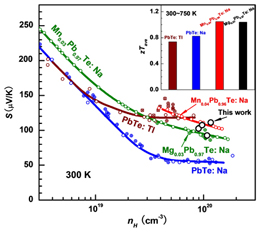Pb1−xMnxTe合金における熱電能向上およびその熱電効率への影響
Thermopower enhancement in Pb1−xMnxTe alloys and its effect on thermoelectric efficiency
2012年9月21日 NPG Asia Materials 4, e9 (2012) doi:10.1038/am.2012.52
熱電材料:バンド効果

熱流を電流に、電流を熱流に変換できる熱電材料は、冷却や発電への応用が期待される物質である。このたび、同済大学(中国)のYanzhong Peiおよびカリフォルニア工科大学(米)のJeffrey Snyderを中心とする共同研究チームは、最先端の熱電材料であるテルル化鉛(PbTe)をテルル化マンガン(MnTe)と合金化することによって、熱電効率を向上させることに成功、さらに、この効率向上の原因となる機構を提示した。PbTe の特性は、ドーピングや他材料との合金化によって向上させることができる。こうした組成調整は、熱伝導の低減や電気的特性の向上を可能にするが、特に電気的特性については、共鳴状態の導入あるいは多重バンド伝導の利用によって、特性が向上する。研究チームは、ドーピングされた他のPbTe材料との比較を通して、MnTeとの合金化による性能向上は多重バンド伝導に起因するものであると示唆するとともに、このバンド効果が共鳴状態生成よりも効果的であることを示している。
Thermoelectric materials: Band effects
Thermoelectric materials, which can convert a heat flow into an electrical current, and vice versa, have potential for applications in cooling and in power generation. Yanzhong Pei, Jeffrey Snyder and co-workers from Tongji University in Shanghai and the California Institute of Technology have now enhanced the efficiency of a state-of-the-art thermoelectric material, lead telluride, by alloying it with manganese telluride (MnTe), and proposed a mechanism to account for this improvement. The properties of lead telluride can be improved by doping and alloying it with other species. This tuning in composition can reduce its thermal conduction or improve its electronic properties – the latter either by introducing resonant states or by utilizing multiple band conduction. Through comparisons with other doped PbTe materials, Pei, Snyder and co-workers suggest that the MnTe-induced performance enhancement arises from multiple band conduction. They also show that these band effects are more effective than the formation of resonant states.

